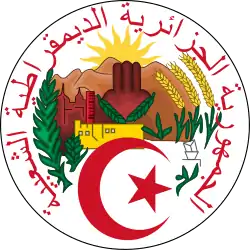Next Algerian legislative election
The next Algerian legislative election must take place in 2022 at the latest in order to elect for five years the 462 deputies of the Algerian National People's Assembly. Early elections are, however, expected in the context of an ongoing constitutional review.
| |||
|
| |||
| |||
 |
|---|
| This article is part of a series on the politics and government of Algeria |
|
|
Background
2017 Legislative election
The legislative election of May 2017 were characterized by a low turnout of 35%, lower than the 43% of the legislative elections of 2012. Polls show a renewal of the ruling coalition, a alliance between the National Liberation Front (FLN) and the National Rally for Democracy (RND), which retains the absolute majority of seats in the National People's Assembly, despite a sharp decline in the FLN.[1]
Society in Algeria has been tense for several years due to the fall in the price of a barrel of oil with the government never having succeeded in ending the country's dependence on hydrocarbons, which represent 60% of the state budget. A large part of the population is encountering economic difficulties due to the impact of this fall in the national budget on the prices of basic necessities which are heavily subsidized by the state.[2]
2019–20 Algerian protests
President Abdelmadjid Tebboune, controversially elected in December 2019 following the massive protests known as "Hirak", initiated a constitutional reform at the start of his term which led to the holding of a referendum on November 1, 2020. President Tebboune declared that an early dissolution of the two chambers of parliament would take place in late 2020 if the new constitution is approved by the population.[3][4] While the referendum was approved, the call for new election was delayed by the transfer of Tebboune to Germany for over two months to get treatment for Covid-19.
Electoral system
The 462 members of the People's National Assembly are elected by proportional representation from 48 multi-member constituencies based on the provinces. Seats are allocated using the largest remainder method.[5]
References
- Législatives algériennes: une défaite générale, liberation.fr, 5 mai 2017
- "Elections législatives en Algérie : vers une abstention historique ?" (in French). 2017-05-04. Retrieved 2017-05-04..
- https://www.tunisienumerique.com/algerie-abdelmajid-tebboune-annonce-des-elections-legislatives-anticipees/
- https://news.trust.org/item/20200920225436-chm0e/
- Al-Majlis Al-Chaabi Al-Watani (National People's Assembly) IPU